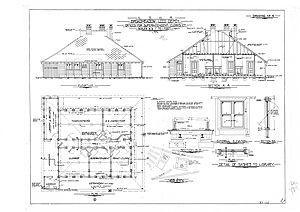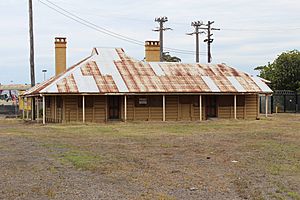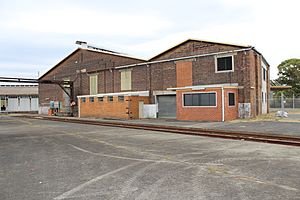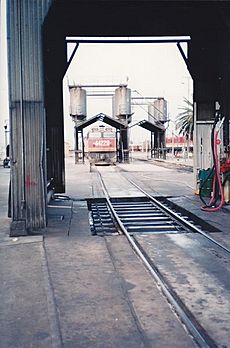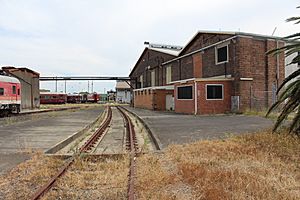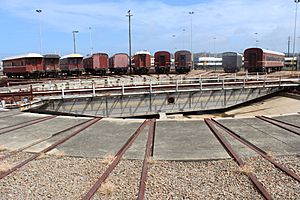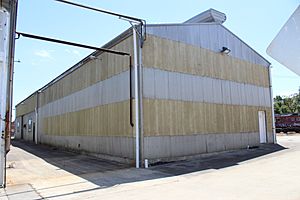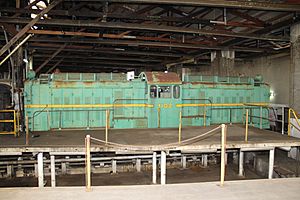Broadmeadow Locomotive Depot facts for kids
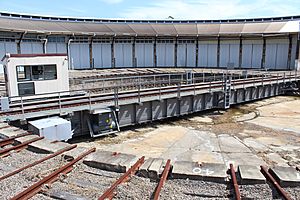
Electrically powered 32 m (105 ft) diameter turntable serving No. 2 Roundhouse
|
|
| Location | |
|---|---|
| Location | Broadmeadow, New South Wales |
| Coordinates | 32°55′35.6″S 151°43′35.60″E / 32.926556°S 151.7265556°E |
| Characteristics | |
| Owner(s) | Transport Asset Holding Entity |
| Operator(s) | FreightCorp |
| Depot code(s) | 2 |
| Type | Twin roundhouse |
| Roads | 2 x 21 undercover |
| Routes served | Main Northern |
| History | |
| Opened | 1924 |
| Closed | 24 December 1994 |
The Broadmeadow Locomotive Depot (also known as NSW depot number 2) was a huge train maintenance centre. It had two roundhouse buildings and other facilities. These were built by the New South Wales Government Railways next to the train sorting yard. This depot was on the Main Northern line at Broadmeadow.
Building the depot started in 1923. It was meant to replace the old, crowded train sheds at Hamilton. The Broadmeadow depot officially opened in March 1924. It is now a protected heritage site, added to the New South Wales State Heritage Register in 1999.
History of the Depot
Early Days and First Facilities
When it first opened, the depot had a large, manually operated turntable. This was a spinning platform 23 m (75 ft) across. It had 42 tracks coming off it, like spokes on a wheel. Twenty-one of these tracks were inside a wooden roundhouse building.
All 21 tracks inside the roundhouse had long pits underneath. These allowed workers to inspect the trains from below. There were also special "drop pits" for removing train wheels. Water for the steam trains came from three large tanks. Offices for engineers and staff were built using a special concrete panel method. A rest building was also available for train crews.
Trains were refueled with coal from a huge wooden coal bunker. This bunker could hold 1,000-tonne (1,000-long-ton) of coal. It was 76 m (250 ft) long and 11 m (37 ft) high. It also had areas to store and dry sand, which trains used for grip on the tracks.
A workshop building was also part of the depot. It had machines like a wheel lathe to fix train wheels. It also had tools for general repairs and a blacksmith's area. A meal room for 140 staff was built near the workshop.
Special "de-ashing" pits were used to remove ash from the steam trains. These pits had a sunken track below them. Wagons would sit there to collect the ash. In 1925, a shed was built over these de-ashing pits.
Adding a Second Turntable
In July 1926, a second turntable was finished. This No. 2 turntable was also 23 m (75 ft) wide and manually operated. It also had 42 tracks coming from it. Unlike the first turntable, these tracks were not covered by a roundhouse at first. There were even plans for a third turntable and roundhouse, but they were never built.
More Buildings and No. 2 Roundhouse
In 1927, another large water tank was added. Not much changed until 1945. Then, a third de-ashing pit was built. The main engineer's office was also made bigger. The No. 1 turntable was upgraded to use electric power instead of being manually operated.
In 1947, new and better facilities for employees were built. This included a new meal room, lockers, and showers. It could hold 144 people for meals and had lockers for 300.
Planning for a roundhouse over No. 2 turntable began in 1948. However, it wasn't finished until 1951-52. This new roundhouse had 21 covered tracks, each with long service pits. It was built with brick walls and a corrugated iron roof. At the same time, the old 23 m (75 ft) turntable was replaced. A larger, 30 m (100 ft) electrically operated turntable was installed. These upgrades were needed to handle the new, larger D58 class locomotives. A new office for the main engineer was also built around this time.
In 1952, more "drop pits" were added to No. 2 shed. These pits helped with repairing train wheels. Hoists were also installed in the roof to lift heavy parts. Some service pits in No. 2 shed were also made longer.
Changes for Big Garratt Locomotives
In 1954, the No. 2 roundhouse was extended. This was to fit the huge AD60 class Garratt locomotives. This extension cost a lot of money. The tracks and pits were made much longer to fit these massive trains.
To handle the Garratt locomotives, the No. 2 turntable was also made bigger. It became 32 m (105 ft) in diameter. The coal stage was also changed to make it easier to refuel the Garratt trains. An extra departure track with a de-ashing pit was added. These pits were used to clean ashes from trains before they left the depot.
Adapting for Diesel Trains
When diesel locomotives started to be used, the depot needed new facilities. Fuel storage and refuelling areas were added. A large fuel oil tank was installed in 1961.
In 1962, six tracks in No. 2 shed were updated for diesel trains. The old steam pits were removed. New raised service pits were installed instead. These new pits had platforms for workers to access the trains. This diesel area was separated from the steam section. It had better lighting and ventilation. New rooms for diesel parts and oil tanks were also built.
In 1965, a special machine called a "wheel lathe" was bought. This machine was used to fix the wheels of diesel trains. It was placed in a new shed built for it. This shed also had an overhead crane.
Two outdoor tracks from No. 2 turntable were connected to the main Broadmeadow yards. They became new arrival tracks. A new sanding plant for diesel trains was built on one of these tracks. In 1966, a new diesel fuel storage area was installed. It had four large tanks and a pump house. More fuelling points were added to the new arrival tracks.
A "load box" building was built on an outdoor track. This allowed workers to test the power of diesel-electric trains after repairs. A new air compressor house was also built near No. 2 Roundhouse.
The End of Steam Trains
In March 1970, a new office and staff building was completed. This replaced several older buildings, which were then knocked down. In December 1970, two steam locomotives were brought in. They were used as stationary boilers, not for pulling trains.
In October 1971, a two-track shed was built over the diesel refuelling area.
In July 1972, the sanding facilities for diesel trains were improved. Two large sanding sheds were built on the arrival tracks to No. 2 Roundhouse.
Broadmeadow Loco Depot was the last place in New South Wales to regularly use steam trains. The last scheduled steam passenger train left on July 24, 1971. The very last mainline steam train from the depot ran on February 24, 1973. This marked the end of steam trains at Broadmeadow.
In 1974, the old water tanks and columns were removed. A steam cleaning shed was built between the two roundhouses. In 1977, the large coal stage was demolished. By the late 1970s, No. 1 roundhouse was no longer used for trains. It became a storage area and for wagon repairs.
Later Changes and Closure
In late 1977, the Garratt Shed tracks in No. 2 shed were rebuilt. They were shortened and fitted with raised pits. These pits had platforms for workers. The area above these tracks was given a false ceiling and exhaust fans. Cranes were also installed. Offices and storage areas were created in this section. In 1979, two de-ashing pits near No. 2 shed were filled in.
In June 1984, the Main Northern line was electrified. A track next to the depot was also electrified for electric trains.
In 1984, a new building for first aid and female staff was built. In 1985, a new waste water treatment plant was constructed. This plant cleaned the dirty water from the depot's pits. In 1987, a three-track centre for maintaining railcars was built. This centre was managed separately from the main depot. A new brick rest building for train crews was also built in 1987.
In 1988, the old workshop buildings were demolished. A more modern steel-framed building replaced the machine shop. This new building was twice as long and also used for storage.
In March 1988, a new "drop table" was installed in No. 2 shed. This special table helped with train repairs. As part of this work, some old tracks and pits were removed or changed.
In 1990, the original No. 1 roundhouse building was demolished. The old mess room was also removed. After No. 1 shed was gone, its turntable pit was raised to help with groundwater. All the service pits around No. 1 turntable were filled in. In 1991, more pits around No. 2 turntable were filled in or modified.
Closure of the Depot
In 1994, new 82 class and 90 class trains were introduced. These were maintained elsewhere. Many older trains were taken out of service. This meant the depot was used less and less. The Broadmeadow Locomotive Depot officially closed on December 24, 1994.
The Depot After Closing
In the late 1990s, most of the depot's movable equipment was sold off. This included the wheel lathe, cranes, sanding sheds, and diesel fuel tanks. The machinery in the workshop building was also removed. This building then became a store for the nearby railcar maintenance centre. It was the only building still actively used by the railway.
In 2004, the railcar maintenance centre was made bigger. This meant some of the outdoor tracks of No. 2 shed had to be shortened. The "load box" building was also removed. The arrival tracks for No. 2 shed were disconnected from the main line.
The remaining part of the depot is now a heritage site. In 2009, some historic trains from the New South Wales Rail Transport Museum were moved to Broadmeadow for storage. Work began to repair No. 2 roundhouse and its turntable. This was to allow some of these historic trains to be stored undercover.
In early 2011, the original 1924 concrete barracks building was demolished. This was due to a lot of damage and because it was outside the main heritage area.
There have been proposals to turn the site into a rail heritage centre. Local groups are interested in looking after the site and its stored items. However, in 2018, it was announced that all items stored at Broadmeadow would move to another site. After that, the Broadmeadow site will be used for new purposes.
What's Left at the Depot?
The Broadmeadow Locomotive Depot is a large area on the western side of the railway line. It still has parts of the old train servicing facilities. These include two turntables, though one roundhouse is gone. There are also washing areas and the old engineer's office.
Tracks were set up for trains to arrive and leave the depot. The layout of these tracks has changed over time. A newer train servicing centre, built in the 1980s, now sits between the old roundhouses and the main tracks. Its parking area has taken over some of the old tracks.
The buildings that are still standing include:
- No. 2 Roundhouse (built 1951–52) and its 32 m (105 ft) Turntable.
- The former District Engineer's Office (built 1924).
- No. 1 Turntable (built 1924).
- The Diesel Refuelling Facility (built 1971).
- Some newer storage sheds (from the 1990s).
No. 2 Roundhouse and Turntable
The No. 2 roundhouse and turntable are still there. The roundhouse has 42 tracks arranged in a fan shape. These tracks spread out from the central turntable. The roundhouse building covers 21 of these tracks. The other tracks and access roads are open to the sky.
The roundhouse has a peaked roof with smoke vents above each track. It also has skylights. The walls are made of brick, and the roof is supported by concrete columns. Large glass windows are on the outer walls. There are still some metal doors facing the turntable.
Inside, the floor is mostly concrete. There are inspection pits and steps to allow workers to get under the trains. These pits were changed when diesel engines arrived. There are also raised work platforms for working on the upper parts of trains. Offices and storage areas were once inside this building. A compressor shed is at the southern end with some old equipment.
The 32 m (105 ft) electrically powered turntable is also still there. It was upgraded when the roundhouse was built. Work began in 2009 to repair the roundhouse and turntable.
Old District Engineer's Office
The former District Engineer's office is in the middle of the western part of the site. It's a single-story building with a corrugated metal roof. It has a deep veranda on three sides with concrete floors.
This building was made using a special method. Prefabricated concrete slabs were dropped between slotted concrete posts to form the walls. This type of construction was common for railway buildings in the early 1900s.
Inside, the building is simple. The walls are lined, and the ceilings are made of fibre-cement. The floors are timber. All the windows are old-fashioned wooden ones. This building is in poor condition now, with many broken windows.
No. 1 Turntable
The No. 1 turntable dates back to 1924. It is an electric turntable and still works. It was raised when its roundhouse was demolished in the 1990s. The original electric drive was removed, but a replacement was fitted in 2016.
Refuelling Facility
Next to No. 2 Turntable is a metal building with a corrugated iron roof. It has two sections for refuelling trains.
Newer Sheds
Between the two turntables are several modern metal buildings. They have gabled metal roofs and are mostly used for storage. One long building is open at both ends. It has high platforms and a central pit for cleaning trains. Other portable buildings are also in the area. These newer structures are not considered historically important.
Landscape and Hidden Features
Southwest of No. 2 Turntable, there is a row of Canary Island date palms. They follow the line of the tracks.
There are likely many old pits, pipes, and parts of former tracks hidden underground. Many features have been removed from the site. These include the large coal stage, water tanks, and the No. 1 roundhouse. However, some archaeological evidence of these might still remain.
The Broadmeadow Locomotive Depot still looks much like it did in the past. Even though the original 1924 roundhouse is gone, most of the main parts of the site are still there.
Why Broadmeadow Depot is Important
The Broadmeadow Locomotive Depot is very important to the history of New South Wales. It was the main place for servicing steam trains in northern NSW. It took over this role from the Hamilton Depot. It was also the last depot in NSW to run regular steam train services.
The large site has many buildings and features. They show how the depot worked and how technology changed from steam to diesel trains over 80 years. The roundhouses show a shift in train maintenance. They moved from the British style of "through-houses" to the American style of "roundhouses." Even though some parts of the depot are gone, it still shows its importance. The turntables, the 1951-52 roundhouse, and the old engineer's office all help tell its story. The site physically shows a time of train servicing that no longer happens.
The Broadmeadow No. 2 roundhouse is quite rare in NSW. Many roundhouses were built, but only seven (or parts of them) are still standing. The Broadmeadow No. 2 roundhouse and turntable are among the largest remaining. It's even rarer because there were two roundhouses on the same site, and both turntables still exist. Both turntables are also in working order.
Broadmeadow Railway Locomotive Depot was added to the New South Wales State Heritage Register on April 2, 1999.
Historical Importance
The Broadmeadow Locomotive Depot is important because it shows the history of New South Wales. Along with the nearby Cardiff Locomotive Workshops, it shows how much the NSW rail system grew. It also shows its ability to build and service trains in the early to mid-1900s. Broadmeadow Depot was the main place for steam trains in northern NSW. It was the last depot in NSW to run regular steam train services.
The site shows how train technology changed from steam to diesel over 80 years. The roundhouses show the shift from British to American train maintenance styles. Even with some parts removed, the site still shows its importance. The turntables, the 1948 roundhouse, and the offices all help tell the story. The site physically shows an old way of servicing trains that doesn't happen anymore. The railways were once the biggest employer in NSW. The Broadmeadow depot had a big impact on the local economy.
Design and Technical Importance
The Broadmeadow Locomotive Depot is also important for its design and technical achievements. This is mainly because of the 1948 roundhouse and turntable. The buildings still look much like they did. They show the age and use of the site. The size of the building creates a dramatic industrial space. This shows how big the train servicing operations were.
The former Chief Engineer's office is a good example of an early 1900s concrete slab building. This style was common across the railway network.
Community Connection
The depot has the potential to connect the local community to its history. It likely has high social value for former staff and their families.
Research Potential
The Broadmeadow Locomotive Depot has some potential for archaeological research. Remains of demolished buildings and works could help us learn more about how the site operated.
Rarity
The Broadmeadow No. 2 roundhouse is quite rare in NSW. Steam locomotives were the main type of train for about 110 years (1855-1965). Many servicing facilities were built, including about 120 sheds and 25 roundhouses. But only seven roundhouses (or parts of them) are still standing. The Broadmeadow No. 2 roundhouse and turntable are among the largest remaining. The oldest is at Valley Heights.
The Broadmeadow complex is even rarer because it had two roundhouses on the same site. Both turntables still work. It still shows its busy past, even though the 1924 roundhouse is gone. It is the only railway complex in NSW with two working turntables side-by-side. The original Resident Engineer's office also adds to its rarity.
Example of its Type
The Broadmeadow roundhouse is a good example of an industrial building type. These buildings were once common but are now rare. The roundhouse follows a standard design seen in other places like Casino, Cowra, Muswellbrook, and Temora. The Broadmeadow No. 2 roundhouse is still intact. After conservation work, it will be in good condition and operational.


